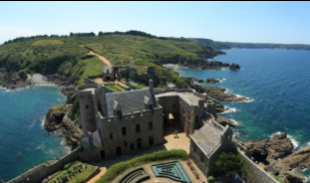Enter the lair of the Tiger

During your holiday on the Vendée coast, you are looking for a fun visit that will also allow you to take a trip back through more than a century of French history. In Saint Vincent sur Jars, stop at a Vendée farmhouse overlooking the ocean. It was the last refuge of one of the most important men of the 19th and 20th centuries, Clémenceau.
Don't expect to visit a beautiful manor house or come across some ostentatious residence. ‘A fisherman's hut facing the sea’, ‘my shack’ - these are the terms Clémenceau used to describe this house perched on a dune. Of all the national museums for which the state is responsible, this is certainly one of the most modest.
A shack... completely occupied
 At first glance, it is hard to imagine that this farmhouse, which seems to have been ‘standing’ there for centuries, battered by the winds and sea spray, has housed a ‘giant of history’. To put it simply, you go in at one end and come out at the other. As in all farmhouses, the rooms are arranged in a row, from the old garage (which is used as an exhibition hall) to Clémenceau's ‘bedroom-office’, via the large kitchen, the guest bedrooms and the library containing more than 1500 books. Everything has remained as it was: the furniture, the books, Clemenceau's desk and his collection of exotic art. This house still seems to be inhabited by this great man. He went for a walk in the garden... and he's coming back.
At first glance, it is hard to imagine that this farmhouse, which seems to have been ‘standing’ there for centuries, battered by the winds and sea spray, has housed a ‘giant of history’. To put it simply, you go in at one end and come out at the other. As in all farmhouses, the rooms are arranged in a row, from the old garage (which is used as an exhibition hall) to Clémenceau's ‘bedroom-office’, via the large kitchen, the guest bedrooms and the library containing more than 1500 books. Everything has remained as it was: the furniture, the books, Clemenceau's desk and his collection of exotic art. This house still seems to be inhabited by this great man. He went for a walk in the garden... and he's coming back.
A... ‘palette of brushstrokes in the undergrowth’
 The other jewel of the « Maison de Clémenceau » is its huge garden, which ‘serves as a setting’ for it and which slopes down on one side almost to the sea. His great friend Monet, when visiting Saint Vincent sur Jars, spoke of it as ‘a palette of brushstrokes in the undergrowth’. At first glance, it looks like a huge mess, an abandoned park. Then, as you walk around, little by little, you realise that each tree or shrub is in its place, that there are paths where you can lose yourself. Like an impressionist painting, when you take a step back, it takes your breath away. It is the result of a lot of work. For years, Clémenceau mixed the sand from the dune, on which the house is built, with earth to make all these plantations. The result is this slightly crazy garden. A little advice: at the end of the visit, go down to the bottom of the garden, sit for a while on one of the benches facing the ocean and... watch the time go by!
The other jewel of the « Maison de Clémenceau » is its huge garden, which ‘serves as a setting’ for it and which slopes down on one side almost to the sea. His great friend Monet, when visiting Saint Vincent sur Jars, spoke of it as ‘a palette of brushstrokes in the undergrowth’. At first glance, it looks like a huge mess, an abandoned park. Then, as you walk around, little by little, you realise that each tree or shrub is in its place, that there are paths where you can lose yourself. Like an impressionist painting, when you take a step back, it takes your breath away. It is the result of a lot of work. For years, Clémenceau mixed the sand from the dune, on which the house is built, with earth to make all these plantations. The result is this slightly crazy garden. A little advice: at the end of the visit, go down to the bottom of the garden, sit for a while on one of the benches facing the ocean and... watch the time go by!





